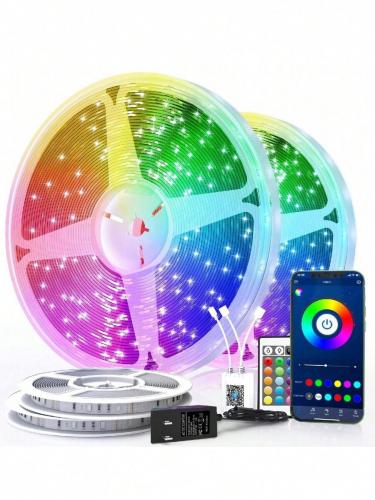What is the difference between RGB and Rgbic lights?

In the realm of modern lighting, the terms RGB and RGBIC are frequently encountered, particularly when exploring options for vibrant, customizable lighting solutions. These technologies have revolutionized the way we illuminate spaces, offering a spectrum of colors and dynamic effects that can transform any environment. However, understanding the differences between RGB and RGBIC lights is crucial for making informed decisions, whether for home decor, entertainment, or professional applications.
RGB, an acronym for Red, Green, and Blue, is a color model used in various electronic displays and lighting systems. RGB lights are capable of producing a wide range of colors by combining these three primary colors in varying intensities. The technology behind RGB lighting involves light-emitting diodes (LEDs) that can be individually controlled to emit the desired color. This capability allows users to create a multitude of colors and effects, making RGB lights popular for decorative purposes, mood lighting, and even in gaming setups.
On the other hand, RGBIC, which stands for Red, Green, Blue, and Independent Control, is an advanced version of RGB technology. The primary distinction between RGB and RGBIC lights lies in the level of control and versatility they offer. While RGB lights allow for the creation of different colors by controlling the intensity of the red, green, and blue LEDs, RGBIC lights take this a step further by enabling independent control of each LED segment. This means that with RGBIC, each segment of the light strip can display a different color simultaneously, allowing for more complex and vibrant lighting effects.
The key to RGBIC's enhanced capabilities is its integrated circuit (IC) chip, which is embedded in the light strip. This chip facilitates the independent control of each LED segment, enabling a more dynamic range of lighting effects such as chasing, rainbow, and gradient patterns. As a result, RGBIC lights are often favored in scenarios where a more sophisticated and visually striking lighting display is desired.
One of the practical implications of these differences is the application and suitability of each lighting type. RGB lights are typically more straightforward and cost-effective, making them ideal for users who require basic color-changing capabilities without the need for intricate effects. They are commonly used for general ambiance lighting, accent lighting, and in situations where a simple color transformation is sufficient.
Conversely, RGBIC lights are better suited for scenarios that demand high levels of customization and visual impact. They are often used in settings such as stage lighting, commercial displays, and high-end home theaters where dynamic and intricate lighting effects can enhance the overall experience. The ability to control each LED segment independently allows for the creation of complex animations and patterns that can captivate audiences and elevate the aesthetic of any space.
Another consideration when choosing between RGB and RGBIC lights is the ease of installation and control. RGB lights are generally easier to install and operate, as they require fewer components and less sophisticated control systems. Most RGB setups can be managed with a simple remote control or a basic smartphone app, making them accessible to a broad range of users.
In contrast, RGBIC lights may require more advanced control systems and a higher level of technical expertise to fully exploit their capabilities. This is due to the complexity involved in managing the independent control of each LED segment. However, many manufacturers provide user-friendly interfaces and apps that simplify the process, allowing users to create and manage intricate lighting displays with relative ease.
Energy consumption is another factor to consider. While both RGB and RGBIC lights are energy-efficient compared to traditional lighting solutions, the additional capabilities of RGBIC lights may lead to slightly higher energy usage. This is because the independent control of each LED segment can result in more LEDs being active at any given time, especially when creating complex lighting effects. Nonetheless, the difference in energy consumption is generally minimal and should not be a significant deterrent for most users.
In terms of longevity and durability, both RGB and RGBIC lights benefit from the inherent advantages of LED technology. LEDs are known for their long lifespan and resistance to wear and tear, making both types of lights a reliable choice for long-term use. However, the additional components in RGBIC lights, such as the IC chip, may introduce additional points of failure, although advancements in technology have made these components increasingly robust.
Ultimately, the choice between RGB and RGBIC lights depends on the specific needs and preferences of the user. For those seeking straightforward, cost-effective lighting solutions with basic color-changing capabilities, RGB lights are an excellent choice. They provide ample flexibility for most decorative and ambient lighting applications without the need for complex control systems.
On the other hand, users who desire more sophisticated lighting displays with the ability to create intricate patterns and effects will find RGBIC lights to be a superior option. The independent control of each LED segment opens up a world of possibilities for creativity and customization, making RGBIC lights ideal for settings where visual impact is paramount.
In conclusion, while RGB and RGBIC lights share a common foundation in LED technology, their differences in control, versatility, and application make them suited to different purposes. By understanding these distinctions, users can make informed decisions that align with their specific lighting needs, ensuring the optimal enhancement of their spaces with vibrant and dynamic illumination.

 Afrikaans
Afrikaans Čeština
Čeština Dansk
Dansk Deutsch
Deutsch Español
Español Francais
Francais Italiano
Italiano Magyar
Magyar Nederlands
Nederlands Norsk
Norsk Polski
Polski Português
Português Română
Română Slovák
Slovák Suomi
Suomi Svenska
Svenska Tiếng Việt
Tiếng Việt Türk dili
Türk dili Ελλάδα
Ελλάδα Русский
Русский اللغة العربية
اللغة العربية แบบไทย
แบบไทย 中文繁體
中文繁體 日本語
日本語 한국인
한국인







